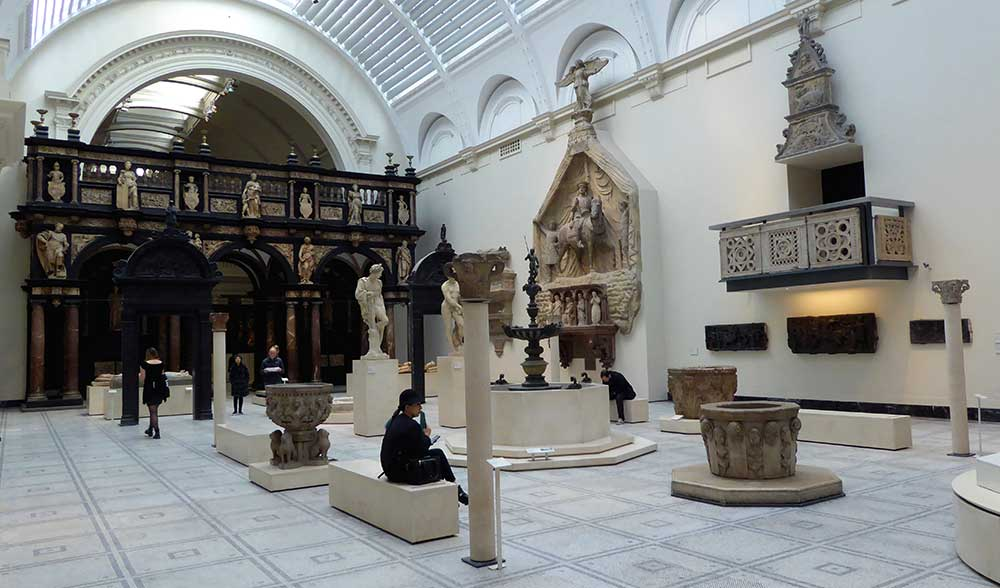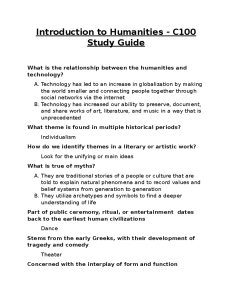The upcoming medieval architecture exhibition titled “Envisioning Cluny: Kenneth Conant and Representations of Medieval Architecture, 1872–2025” promises to captivate audiences with its deep dive into the storied past of one of Europe’s grandest structures. At the heart of this showcase is Harvard architectural historian Kenneth Conant’s groundbreaking work to reconstruct Cluny abbey, a monumental church that was tragically demolished during the French Revolution. Through a blend of hand-drawn sketches, historical photographs, and cutting-edge 3D models, visitors will journey through architectural history and explore the insights gained from Conant’s meticulous research. By focusing on Cluny III, the exhibit intricately weaves together narratives of ambition, loss, and revival in medieval architecture. Join us at the Druker Design Gallery, where the legacy of Cluny’s grandeur can be reimagined and celebrated as never before.
The exhibit centered around medieval structures, spotlighting Conant’s scholarly endeavors in reconstructing the Cluny abbey, showcases a pivotal chapter in architectural exploration. Dubbed “Envisioning Cluny,” the display offers an engaging perspective on how tools for studying historical edifices have evolved from traditional methods to modern technology. Audience members will not only appreciate the beauty of medieval craftsmanship but also understand the cultural significance of such monumental buildings, especially in the context of their destruction after the French Revolution. By utilizing innovative techniques like 3D modeling and virtual reality, visitors are invited to interact with the remnants of a bygone era, enriching their understanding of architectural history. This exhibition, therefore, serves as a bridge connecting our contemporary curiosity with the intricate legacies left behind by our medieval predecessors.
Revisiting Medieval Architecture: The Cluny Abbey Restoration
The medieval architecture exhibition, ‘Envisioning Cluny: Kenneth Conant and Representations of Medieval Architecture,’ serves not only as a tribute to Cluny Abbey but also as a reminder of the architect’s detective work in reconstructing historical fidelity. Kenneth Conant’s journey into the ruins of Cluny III, once the largest building in Europe, highlights the profound influence of architectural history on contemporary scholarship. Through meticulous research and innovative reconstruction methods, Conant brought fresh life to a structure nearly lost to time, exemplifying how historians engage with and interpret our architectural heritage.
The exhibition showcases a rich tapestry of Conant’s work, interweaving his sketches, 3D models, and excavated artifacts to present a comprehensive view of the abbey. This exploration forms an inspiring chronicle of architectural resurgence from rubble to representation, reminding visitors of the grandiosity of Cluny before its destruction during the French Revolution. As patrons wander the gallery, they gain a deeper understanding of Conant’s idealism—his belief that one could imagine a building’s grandeur through detailed examination and comparison with other known historical structures.
The Legacy of Kenneth Conant in Architectural History
Kenneth Conant’s impact on architectural history extends far beyond his tireless work on Cluny Abbey. His scholarly pursuits in the early 20th century coincided with a growing interest in the methodologies of architectural analysis. By integrating traditional historiography with emerging technologies, such as photography and eventually 3D modeling, Conant influenced how historians and architects alike visualize and interact with historical buildings. His legacy is now evident in contemporary tools that allow for a deeper understanding of architectural designs and their monumental narratives.
Educators like Christine Smith, who curate exhibitions like ‘Envisioning Cluny,’ continue to draw on Conant’s pioneering work to bridge the past with modern scholarship. His ability to visualize the abbey’s outdated elements through innovative representation has inspired a generation of students and historians to engage with architectural history dynamically. Smith’s emphasis on interactive technology within the exhibition showcases how far we have come since Conant’s era, further establishing his significance in our understanding of medieval architecture.
The Reconstruction of Cluny Abbey: Challenges and Triumphs
Reconstructing Cluny Abbey was no small feat, as it involved piecing together a narrative from fragments and artifacts left behind after the French Revolution. Kenneth Conant faced tremendous challenges during his studies, striving to fill in the gaps left by time and destruction. Despite only having a handful of surviving capitals and wall remnants, Conant’s rigorous scholarly pursuit and theoretical frameworks laid the groundwork for future restorations and research into Romanesque architecture.
The ongoing study of Cluny III serves as a powerful reminder that architectural history is not merely a record of the past but an evolving dialogue. It echoes through the ages, influencing modern architectural practices and exhibitions. Technologies such as 3D modeling and digital visualization empower historians today to replicate and understand buildings like Cluny Abbey in unprecedented detail, fostering a new generation’s appreciation for the complexities of architectural heritage.
Innovative Technology in Exhibiting Architectural History
‘Envisioning Cluny’ takes a pioneering approach by using contemporary technology to explore historical architecture. The integration of photogrammetry and 3D modeling in the exhibition allows visitors to experience Cluny Abbey beyond static displays. The ability to interact with three-dimensional representations of the abbey helps demystify the architectural components and engage a wider audience, fostering a connection to a period long past.
This innovative approach not only enhances educational offerings but also expands our understanding of how modern audiences can appreciate and visualize historical structures. As viewers manipulate the 3D models, they gain insights that echo Conant’s original aspirations—learning to ‘see’ what is left unspoken within the remnants of monumental buildings. The exhibition thus stands as a testament to how embracing emerging technologies can revitalize our engagement with architectural history.
Exploring the Cluny Capitals: Mysteries and Interpretations
Among the compelling features of Cluny III were its eight capitals, each adorned with intricate designs that have sparked scholarly intrigue for decades. Kenneth Conant’s investigation into these carvings revealed a wealth of artistic expression reflective of the time when they were created. However, their fragmented conditions raised questions about the intended narratives and sequences, inviting diverse interpretations from experts. This ongoing discourse emphasizes the enigmatic allure of medieval artworks.
The capitals are not just relics; they embody a narrative that scholars continue to unravel. Some theorists posited that these monumental pieces reflected the seasons or embodied musical themes, while others point to individual artistic styles and influences. This puzzle, preserved in the exhibition, not only highlights Conant’s work but also illuminates how architecture serves as a canvas for storytelling, bridging the gap between past and present interpretations.
The Evolution of Architectural Study from Conant to Today
Architectural history has undergone profound transformations since Kenneth Conant’s time. In the 1920s, scholars relied heavily on hand-drawn sketches and rudimentary visual aids to understand structures like Cluny Abbey. Today, however, advances in digital technology, including 3D modeling and virtual reality, revolutionize how we engage with architectural studies. ‘Envisioning Cluny’ showcases this evolution, presenting a stark contrast between Conant’s painstaking methods and the rapid, immersive experiences possible in contemporary scholarship.
Students and historians now possess tools that give them unparalleled access to architectural details previously obscured by physical limitations. This has democratized architectural study, allowing for broader insights that can draw in global audiences. As a result, there is a renewed vigor within the field, fueled by technologies that echo Conant’s vision of making the past as tangible and engaging as possible.
The Cultural Importance of Gothic and Romanesque Architecture
The architectural styles of the Gothic and Romanesque periods, epitomized by Cluny III, serve as cultural touchstones that reflect the values and beliefs of their time. Understanding these styles is vital to appreciating their influence on subsequent architectural movements and modern interpretations. The exhibition at Harvard encapsulates this cultural importance by highlighting features of Cluny’s design, allowing visitors to connect deeply with the architectural history that shaped European identity.
Kenneth Conant’s work plays a pivotal role in bridging modern interpretations with the historical significance of these styles. As students and architects explore the intricacies of Gothic and Romanesque architecture, they also engage with broader historical narratives, such as monastic life and its socio-political implications in medieval Europe. The dialogue fostered by such exhibitions enriches our understanding of the cultural imprint left by these architectural masterpieces.
Connecting Historical Context with Modern Architectural Practice
Reflecting on Kenneth Conant’s findings in Cluny, one sees an intricate connection between historical context and modern architectural practices. The exhibition showcases how understanding the histories of structures informs contemporary design decisions and safety protocols, ensuring that the lessons of the past are not forgotten. By analyzing architectural ruins with respect to their original forms, practitioners are better equipped to navigate the challenges of modern construction and preservation.
Moreover, the inclusion of technology in understanding medieval architecture opens pathways for innovative design. Visitors gain appreciation for both the fragility and resilience of structures like Cluny III, prompting modern architects to consider not only their aesthetic contributions but also their cultural significance. The ongoing exploration of architectural history fosters a continuous dialogue between past and present, ultimately enriching our approach to future creations.
The Future of Architectural Scholarship: Lessons from Cluny
As we look towards the future of architectural scholarship, the insights gleaned from Cluny Abbey exemplify the need for an interdisciplinary approach. The collaboration among historians, architects, and technologists, as showcased in the Harvard exhibition, signals a shift towards a more holistic view of architectural study that encompasses creative and analytical methodologies. This evolving scholarship encourages a diverse range of inquiries that are essential for understanding complex historical narratives and their manifestations in contemporary design.
Kenneth Conant’s legacy ultimately reminds us that architectural history is a dynamic field, ripe for exploration and innovation. By leveraging modern technologies and fostering collaboration, future scholars can delve deeper into the worlds of the buildings that shape our environments. The commitment to uncovering, representing, and understanding these architectural marvels is an invaluable endeavor that will continue to illuminate the paths of both academic study and public appreciation for centuries to come.
Frequently Asked Questions
What can I expect to see at the medieval architecture exhibition focusing on Kenneth Conant?
The medieval architecture exhibition titled “Envisioning Cluny: Kenneth Conant and Representations of Medieval Architecture, 1872–2025” showcases the reconstruction efforts of Cluny abbey, which was destroyed after the French Revolution. Visitors will explore hand-drawn sketches, historical photographs, and cutting-edge 3D models that illustrate changes in the study of medieval architecture over time.
How did Kenneth Conant contribute to medieval architecture studies?
Kenneth Conant was a pioneering architectural historian whose work focused on reconstructing the Cluny abbey, the largest building in Europe during the Middle Ages. His meticulous research included extensive excavations and detailed illustrations that aimed to recreate the abbey’s original form, significantly advancing the field of medieval architecture studies.
What technologies are featured in the exhibition on medieval architecture?
The exhibition highlights the transition from traditional methods of studying medieval architecture to modern technologies such as photography, photogrammetry, and interactive 3D models. These advancements allow visitors to engage with the Cluny abbey’s intricate designs in ways that were previously unimaginable.
Why is Cluny abbey important to the study of medieval architecture?
Cluny abbey, particularly Cluny III, is significant as it was a monumental architectural achievement of the medieval era, influencing many subsequent buildings. Its extensive size and intricate design provide rich material for the study of architectural history, illustrating the evolution of styles and techniques used during the medieval period.
What role do the Cluny capitals play in understanding medieval architecture?
The Cluny capitals are crucial in the study of medieval architecture as they represent some of the earliest examples of figural sculpture in the Romanesque style. Their ornate designs offer insight into the artistic and cultural values of the period, and their partial preservation poses ongoing questions about the narrative they convey.
What period does the medieval architecture exhibition cover?
The exhibition covers a broad period from 1872 to 2025, reflecting on Kenneth Conant’s contributions and the evolving methods of representing and understanding medieval architecture, particularly through the lens of Cluny abbey.
Where can I find the medieval architecture exhibition on Cluny abbey?
The exhibition “Envisioning Cluny: Kenneth Conant and Representations of Medieval Architecture, 1872–2025” is located in the Druker Design Gallery and is available for viewing until April 4. Visitors can engage with the digital and physical representations of Cluny abbey during this period.
How does the exhibition enhance our understanding of architectural history?
By showcasing Kenneth Conant’s archival research and the latest technologies, the medieval architecture exhibition provides visitors with a multifaceted understanding of architectural history. It illustrates how past and present methodologies can combine to deepen our appreciation of structures like Cluny abbey and their impact on modern architecture.
| Key Points |
|---|
| The exhibition traces Kenneth Conant’s efforts to reconstruct Cluny III abbey. |
| The abbey was the largest building in Europe before its destruction during the French Revolution. |
| Modern technology showcases how students can interact with 3D models of the abbey’s capitals. |
| The exhibition includes a variety of representations of medieval architecture from sketches to VR. |
| Conant aimed to understand the original form of the abbey through detailed illustrations and excavations. |
| The Cluny capitals are an ongoing mystery with various theories about their design and symbolism. |
| The exhibit runs until April 4 in the Druker Design Gallery. |
Summary
The medieval architecture exhibition, “Envisioning Cluny: Kenneth Conant and Representations of Medieval Architecture, 1872–2025,” showcases the deep impact of technology on our understanding of past structures. This exhibition not only honors the work of Kenneth Conant, who dedicated his life to reconstructing the grandeur of Cluny III abbey but also demonstrates how current scholars can utilize advanced tools to interact with architectural relics in previously unimaginable ways. With a focus on the intricacies of medieval design and the ongoing mystery of the abbey’s capitals, the exhibit invites visitors to experience history through the lens of modern architectural scholarship.




